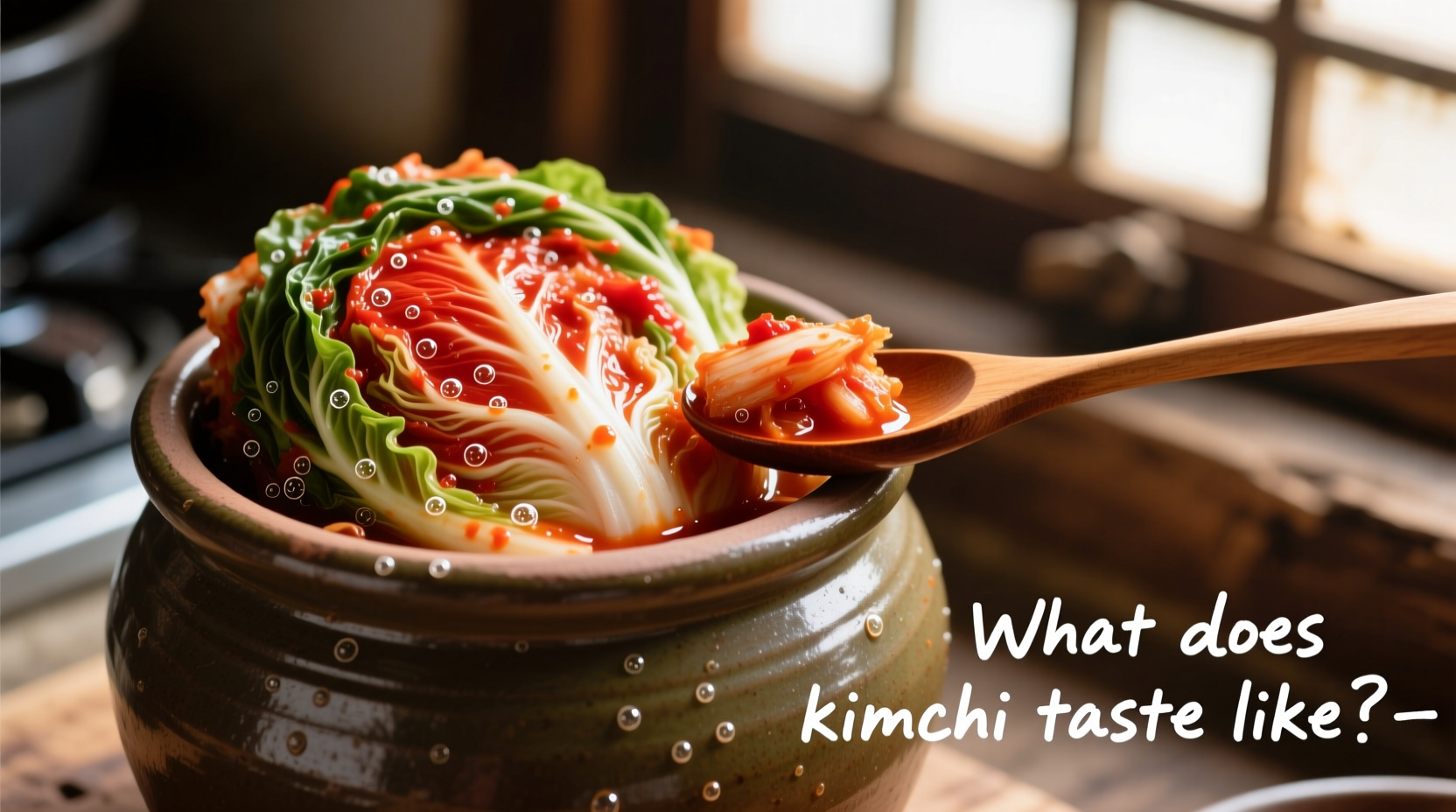Curious about kimchi's distinctive flavor? You're not alone. This Korean staple has captivated global palates, but its unique taste profile often leaves newcomers wondering: what does kimchi taste like exactly? Understanding kimchi's flavor requires exploring its dynamic components that evolve from preparation through fermentation.
The Core Flavor Components of Kimchi
Kimchi's taste isn't static—it's a symphony of evolving flavors. The base napa cabbage provides a clean, slightly sweet canvas that transforms during fermentation. Traditional Korean red pepper flakes (gochugaru) deliver moderate heat with distinctive earthy notes rather than overwhelming burn. Garlic and ginger contribute aromatic pungency that mellows beautifully over time.
What makes kimchi truly special is its natural lactic acid fermentation process. As beneficial bacteria consume sugars, they produce lactic acid that creates that signature tang. This process develops umami compounds that give kimchi its satisfying savory depth—similar to aged cheeses or cured meats but entirely plant-based.

How Kimchi Flavor Changes Over Time
One crucial aspect many miss: kimchi taste evolves significantly during fermentation. What beginners often mistake for "spoiled" is actually perfectly normal development. Let's examine this transformation:
| Fermentation Stage | Flavor Profile | Texture | Best Uses |
|---|---|---|---|
| Fresh (1-3 days) | Mildly spicy, crisp vegetable flavor | Firm, crunchy | Salads, sandwiches |
| Mature (1-2 weeks) | Balanced sour-spicy, pronounced umami | Slightly softened | Stir-fries, fried rice |
| Aged (3+ weeks) | Strong sour notes, complex depth | Soft, tender | Stews, soups |
According to research published in the Journal of Food Science, kimchi's lactic acid content increases from 0.3% to 0.8% during the first two weeks of fermentation, directly impacting its sourness. The optimal flavor balance typically occurs around the 10-14 day mark when sourness, spiciness, and umami reach harmony.
Regional Variations in Kimchi Flavor
Not all kimchi tastes the same—regional differences significantly impact flavor. The Korean Food Research Institute documents how coastal regions incorporate more seafood for briny notes, while mountainous areas use wild greens for earthier profiles.
- Winter kimchi (Gimjang): Made with thicker cabbage layers and more garlic for extended fermentation
- Water kimchi (Mul-kimchi): Lighter, less spicy version popular in summer with refreshing cucumber notes
- Radish kimchi (Kkakdugi): Crunchier texture with sharper, cleaner heat from Korean radish
These regional variations demonstrate how kimchi taste profile changes based on local ingredients and climate. Coastal versions often include salted shrimp or anchovy sauce (jeotgal) that add distinctive umami depth absent in inland varieties.
Common Misconceptions About Kimchi Flavor
Many first-time tasters approach kimchi with inaccurate expectations. Contrary to popular belief, authentic kimchi shouldn't taste overwhelmingly spicy. The heat from Korean red pepper flakes is more aromatic than burning—typically registering between 4,000-8,000 Scoville units, milder than jalapeños.
Another misconception: kimchi's sourness indicates spoilage. Properly fermented kimchi naturally develops tanginess as lactic acid increases. Food safety experts at the USDA confirm that properly stored kimchi remains safe for months, with flavor continuing to evolve rather than deteriorate.
How to Describe Kimchi's Taste to Others
Struggling to articulate kimchi's complex flavor? Use this descriptive framework that culinary professionals employ:
- Primary notes: Start with the dominant flavors (sour, spicy, umami)
- Secondary characteristics: Mention texture and mouthfeel (crisp, effervescent)
- Flavor evolution: Note how taste changes from first bite to finish
- Comparisons: Reference familiar foods ("like sauerkraut but with more complexity")
For example: "Fresh kimchi offers crisp cabbage with mild garlic notes and gentle heat, finishing with refreshing tang. As it ferments, it develops deeper sour notes with umami richness similar to aged cheeses."
Tips for First-Time Kimchi Tasters
If you're new to kimchi, follow these professional recommendations for the best experience:
- Start with freshly made kimchi (1-3 days old) for milder flavor
- Try small portions alongside rice to balance intensity
- Chill kimchi before serving to moderate strong flavors
- Pair with neutral foods like tofu or plain rice initially
- Give your palate multiple exposures—flavor appreciation often grows
Remember that what kimchi tastes like depends significantly on your personal flavor preferences. Those accustomed to fermented foods may appreciate aged kimchi immediately, while others might prefer starting with fresher versions.
Understanding Kimchi's Global Flavor Adaptations
As kimchi has spread worldwide, regional adaptations have emerged that alter its traditional taste profile. While purists might frown upon these variations, they demonstrate kimchi's versatility:
- Western adaptations: Often sweeter with reduced spice levels
- Vegan versions: Substitute fish sauce with mushrooms for umami
- Quick kimchi: Vinegar-based versions lack fermentation complexity
When exploring commercial products, check labels carefully—many mass-produced versions contain vinegar instead of relying on natural fermentation, creating a fundamentally different kimchi taste experience.











 浙公网安备
33010002000092号
浙公网安备
33010002000092号 浙B2-20120091-4
浙B2-20120091-4